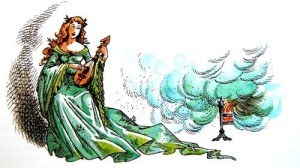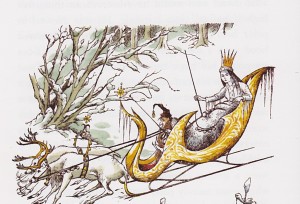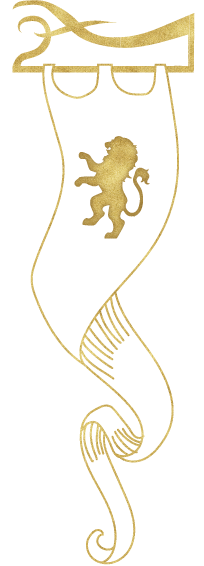by always narnian
It seems like often times the White Witch and the Lady of the Green Kirtle have been connected in some way. In the BBC adaptations, the same actress, Barbara Kellerman, portrays both the White Witch in The Lion, the Witch and the Wardrobe as well as the Lady of the Green Kirtle in The Silver Chair. However, this could be a coincidence, as Barbara Kellerman also played the Hag in Prince Caspian. When a newer Silver Chair film was being discussed, it seemed that often times people wondered if Tilda Swinton would return, starring as the Green Lady of Underland. But why? How has this become a popular idea? Could the White Witch and the Lady of the Green Kirtle be one and the same enchantress? Why do these two villains seem so often associated with one another?
Our first and most obvious argument against this idea may be that Aslan killed the White Witch in The Lion, the Witch and the Wardrobe.
“The battle was all over a few minutes after their arrival. Most of the enemy had been killed in the first charge of Aslan and his companions; and when those who were still living saw that the Witch was dead they either gave themselves up or took to flight.”
She was dead, no doubt, for even her armies saw her as dead. The only possible explanation around this would be that she only appeared dead, but then Aslan would have made a huge mistake.

Pauline Baynes’ illustration of the Lady of the Green Kirtle

Pauline Baynes’ illustration of the White Witch
In Prince Caspian there is thought toward calling the White Witch back from the dead, but this is hastily stopped by Caspian and a few of his friends in the chapter Sorcery and Sudden Vengeance. But let us theorize that, later on, someone did call the White Witch back and she resurfaces as the Lady of the Green Kirtle. She certainly has changed. Pauline Baynes’ illustrations of the White Witch and the Lady of the Green Kirtle are distinctly different. In the illustrations of Jadis (in both The Magician’s Nephew and The Lion, the Witch and the Wardrobe) she is portrayed as a dark-haired and stern woman, whereas in the illustrations of the Queen of Underland, she appears more fair and almost gentle. Wouldn’t Lewis point out to Baynes that the two Witches were drawn so differently, if, in fact, they were the same person? Lewis was in contact with Pauline Baynes about certain illustrations in the series and it seems Lewis would most likely note this. [1]
These two arguments are valid, but let’s find the passage where this whole theory very possibly originated. Toward the end of The Silver Chair book, we see these two characters mentioned together.
“And while they [Eustace and Jill] slept Prince Rilian was talking over the whole adventure with the older and wiser Beasts and Dwarfs. And now they all saw what it meant; how a wicked Witch (doubtless the same kind as that White Witch who had brought the Great Winter on Narnia long ago) had contrived the whole thing, first killing Rilian’s mother and enchanting Rilian himself. And they saw how she had dug right under Narnia and was going to break out and rule it through Rilian: and how he had never dreamed that the country of which she would make him king (king in name, but really her slave) was his own country.”
This passage is soon followed by a statement from one of the dwarfs:
“‘And the lesson of it all is, your Highness,’ said the oldest Dwarf, ‘that those Northern Witches always mean the same thing, but in every age they have a different plan for getting it.’”
Having debunked the theory of these two ladies being the same enchantress, what does this quote from The Silver Chair actually mean? We know that the Queen of Underland and Jadis were of the same kind. As far as we know, Jadis didn’t have any descendants. We know that nearly all the people in the Witch’s original country, Charn, were killed. What might the old Dwarf in The Silver Chair mean by the Northern Witches? Of course, this could mean that the Lady of the Green Kirtle was a Jinn, as Jadis was. But how did the Green Lady of Underland get into Narnia? We are not told her story and unfortunately I do not have an answer for you.
This statement about the White Witch and the Lady of the Green Kirtle is one of several instances where C.S. Lewis seemed to leave much to the reader’s imagination. It makes you wonder if he himself had any idea who these Northern Witches were and how Jadis and the Lady of the Green Kirtle both fell under this category. What are your thoughts? Has this mystery in Narnia ever stuck out to you?
[1] Examples of Lewis and Baynes’ correspondence can be seen in The Collected Letters of C.S. Lewis: Volume III: Narnia, Cambridge and Joy 1950-1963



I always understood that “Northen Witches” meant witches north of Narnia where I imagine Jadis went between Magician’s Nephew and the Lion the Witch and the Wardrobe.
Good thought =} I should look out for more references like that.
I presumed that “Northern witches” referred to the land to the North of Narnia. I would guess that it would be unacceptable to do the evil magic that Jadis and LotGK were doing inside Narnia, and the Calormenes are also superstitious (specifically afraid of the Northern countries being inhabited by demons), the Archenlanders would have the same rules on magic as Narnia, and Telmarines are against any sort of mythological things, which leaves the only other place witches could go being the sea or the wild wastelands of the North.
Like the Telmarines, Jadis and co. would probably avoid going East due to proximity to Aslan’s Country.
So I am guessing it refers more to where Jadis and co. had their lairs before they tried to take over Narnia.
As a kid, I interpreted those passages as the Northern Witches being witches trained by Jadis who followed her example and the Lady of the Green Kirtle being one of her students rather than a physical descendant. (I also thought the White Witch was a separate character from Jadis and another such student… but then, I was nine years old and not that smart.)